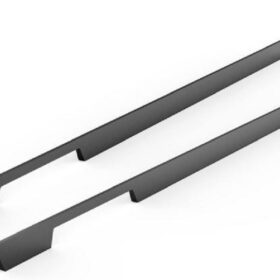Designing Contemporary Kitchens with Counter Handles
In contemporary kitchen design, counter handles have emerged as a stylish and functional element, offering a sleek and ergonomic way to open cabinetry without compromising aesthetics. This article delves into the world of counter handles, exploring their various types, materials, and applications.
Types of Counter Handles
Counter handles come in a wide range of styles to complement different kitchen designs.
– Inset: Inset handles are recessed into the cabinet face, creating a seamless and minimalist look.
– Edge: Edge handles extend along the top or bottom edge of a cabinet, providing a sleek and modern aesthetic.
– Lip: Lip handles feature a small lip extending from the cabinet face, offering a subtle and convenient grip.
– Bar: Bar handles are straight lines that run horizontally or vertically on the cabinet front.
Materials for Counter Handles
Counter handles are crafted from various materials, each with unique properties.
– Stainless Steel: Stainless steel handles are durable, corrosion-resistant, and easy to clean.
– Brass: Brass handles add a touch of warmth and sophistication to the kitchen, and their patina develops over time.
– Aluminum: Aluminum handles are lightweight and resistant to rust, making them ideal for contemporary kitchens.
– Wood: Wood handles provide a natural and rustic element to the kitchen, complementing warm and earthy tones.
Applications of Counter Handles
Counter handles offer versatility in functionality.
– Cabinets: Counter handles are primarily used on cabinet doors to provide a convenient grip for opening and closing.
– Drawers: They can also be used on drawers, offering a seamless and ergonomic way to access the drawer’s contents.
– Appliances: Some counter handles are designed to match appliances, creating a cohesive and polished look in the kitchen.
Design Considerations
When choosing counter handles, several design considerations should be made.
– Style: The style of the handles should complement the overall design of the kitchen, whether modern, traditional, or transitional.
– Material: The material of the handles should be durable and easy to clean, while also reflecting the desired aesthetic.
– Functionality: The handles should provide a comfortable and ergonomic grip while allowing for easy opening and closing of cabinets and drawers.
Conclusion
Designing contemporary kitchens with counter handles is an art of balancing aesthetics and functionality. By understanding the available types, materials, and applications, homeowners and designers can create kitchens that are both stylish and practical, enhancing the overall cooking and living experience. Counter handles have become an integral part of modern kitchen design, offering an elevated experience for homeowners who value both form and function.
-
2024-11-29Top Trends in Modern Kitchen Cabinet Pulls for 2024
-
2024-11-28The Ultimate Guide to Modern Kitchen Cabinet Pulls- Materials, Styles, and Tips
-
2024-11-27Elevate Your Kitchen Design with These Must-Have Modern Cabinet Pulls
-
2024-11-26Sleek and Stylish- The Best Modern Kitchen Cabinet Pulls for a Contemporary Look










